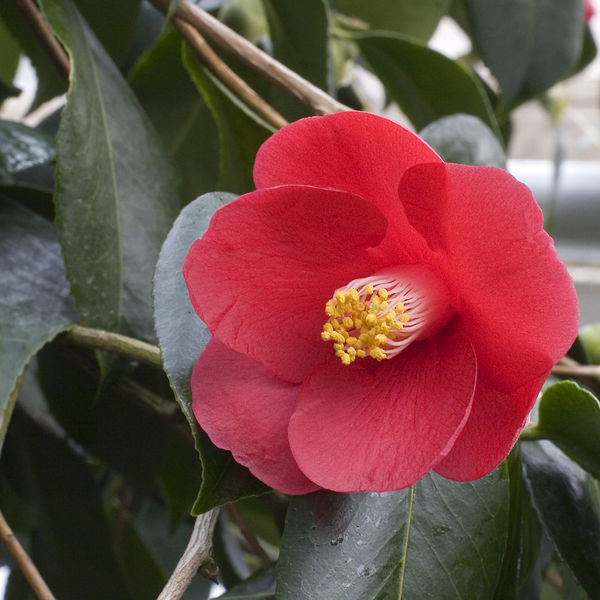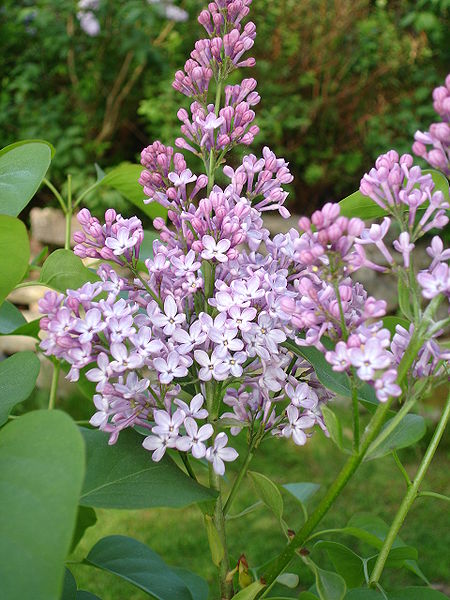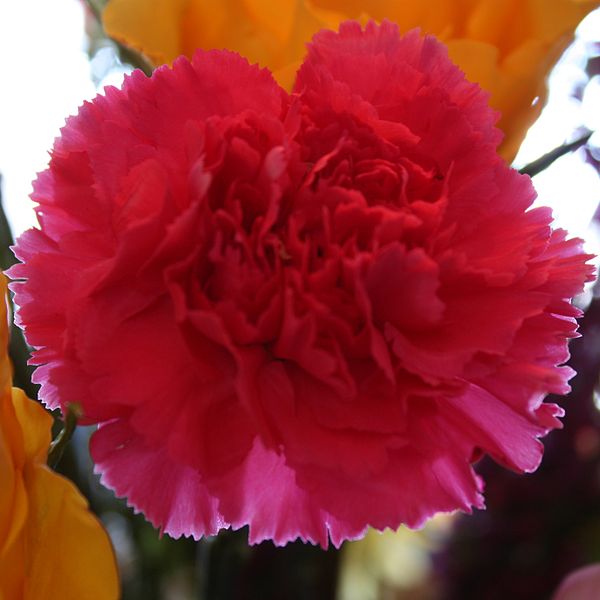
Camellia japonica, state flower of Alabama
I’ve been staying away from politics in this blog — well, mostly — but I think there’s one political issue that hasn’t gotten enough discussion this election cycle: State Flowers.
No, I’m not making it up:
State mushrooms: Minnesota: morel; Oregon: pacific golden chanterelle.State muffins: Maryland: corn muffin; Minnesota: blueberry muffin; New York: apple muffin.
State bat: Virginia: Virginia Big-Eared Bat.
No, really, I mean it. If our elected officials feel that the selection of a State Mushroom, State Bat, and State Muffin is important enough to occupy their time and attention, then perhaps it should occupy a little bit of ours.
I’ve selected State Flowers for my subject because I find that, while forty-six states have managed to select native all-American plants to represent their states, four states have chosen foreign flowers.
Immigrants, in other words.
Alabama, the state of my birth and childhood, proudly names the camellia as its State Flower. This is odd, given that the plant in question, the Japanese Camellia, Camellia japonica, is native not to Alabama, but to — give up? — Japan. (A close relative, by the way, is Camellia sinensis — “sinensis” means “Chinese” in botany-Latin — the shrub that provides tea.)
To add insult to injury, the camellia does not actually grow in most of the state: from Birmingham northwards it is cultivated almost exclusively under shelter, as it cannot tolerate long spells of below-freezing temperatures. In the southern half of the state it suffers during the humid summers from fungal diseases that distort the leaves and kill the flower buds. I’ve known Alabamians who have grown camellias successfully, but only with careful wrapping and mulching in winter and extensive use of fungicides in summer. You’re never going to see big stands of wild camellia bushes by the side of the highway as you’re driving through the Bankhead National Forest. Ironically, the State Flower of Alabama was originally the goldenrod, which really does grow there, but this was replaced in 1959 because the ladies of Butler County felt that such a common wildflower lacked a certain je ne sais quoi.1
In 1999 the state legislature, presumably having nothing better to do, added a State Wildflower, the Oak-Leaf Hydrangea, Hydrangea quercifolia, to lay to rest a certain lingering uneasiness about having a foreigner ruling as State Flower.

Citrus x sinensis, Florida state flower
Florida, not surprisingly, has identified the Sweet Orange, Citrus x sinensis, as its State Flower. As previously mentioned, “sinensis” means “Chinese“, while the letter x indicates that the organism is a hybrid. Oranges are grown in the tropics and sub-tropics worldwide, and have been extensively hybridized and selected, to the extent that the modern orange tree probably bears as little resemblance to its wild Chinese ancestors as the carrot does to Queen Anne’s Lace (both Daucus carota). Unlike the camellia in Alabama, however, orange trees will grow in much of southern Florida without extensive coddling, although they also are prone to fungal diseases and insects that prevent the plants from establishing wild populations of any vigor. The choice of the orange as State Flower, of course, is not really about honoring a humble, much-loved native, but is a nod to the enormous commercial value of the fruit to the Florida economy, wherever it came from.

Syringa vulgaris, state flower of New Hampshire
In New Hampshire, the Lilac, Syringa vulgaris, is the State Flower. This shrub is native to the Balkans, and was probably introduced into western Europe by the Ottoman Turks, who provided cuttings as gifts to the Holy Roman Empire. (The Ottomans also introduced Tulips to Europe.) It was brought into North America in the eighteenth century, and became enormously popular with colonial nurserymen, who immediately began producing a wide range of varieties and hybrids (usually with Syringa x persica, the Persian Lilac, itself a natural hybrid).
Unlike both camellias in Alabama and oranges in Florida, the lilac grows quite well on its own in many parts of the US, especially the New England states, and has naturalized to some degree. It is a “homestead survivor” plant, often persisting on the sites of old abandoned homesites long after every other trace of human presence has been obliterated.

Dianthus caryophyllus, state flower of Ohio, but only when it’s red.
Finally, we come to the great state of Ohio, which has chosen the carnation, or clove pink, Dianthus caryophyllus, as its State Flower. Dianthus species have been in cultivation for millennia over a large part of the world, but probably originated in the eastern Mediterranean; there are a multitude of varieties of D. caryophyllus, including perennials, but in Ohio most carnations are grown as annuals.
Most states choose a particular plant species or variety for their State Flowers: Ohio has gone a step further and chosen a particular color: bright red. Red carnations symbolize, in various parts of the world, the International Labor Movement, the Portuguese revolution of 1974, and final exams at the University of Oxford.
In their defense, the elected officials of these four states had reasons for their unusual choices:
Ohio chose the carnation to honor native son William McKinley, 25th President of the United States, who made something of a trademark of wearing a scarlet carnation in his lapel. McKinley has the distinction of being the second President to die of an assassin’s bullet, shot by Leon Czolgosz as he reached out to shake Czolgosz’ hand during a receiving line at the Pan-American Exposition in 1901.
Florida’s choice of the orange is also difficult to fault: no other crop has had such a significant economic impact on the state. Florida is one of only three states (with California and Hawaii) capable of large-scale commercial production of citrus products, and it is difficult to imagine any other plant that could serve so well as a symbol.
At the same time that the lilac was being introduced into New Hampshire, the state was becoming home to other immigrants, farmers and lumbermen from all over Europe, men and women too poor or too cranky to find places in the pleasant green coastal plains further south. Like Albania, New Hampshire is a place of bitter winters and unpredictable summers, and like the other early settlers in the state, the lilac seems to endure, and even thrive, in harsh conditions without special treatment or care.
Which brings us to Alabama and its camellia. This one is more of a problem, at least for me. The choice of a plant growing reliably in so few parts of the state, and then only under careful cultivation, seems to me to have been clearly intended to exclude most of the population of the state while purporting to represent it. The people who grow camellias are those who have the time and the resources to take care of a temperamental, fragile import — there’s nothing egalitarian about this choice, nothing inclusive. I was born and raised in Alabama and lived there until I was thirty, and never saw camellias growing out in the open, for all to see and enjoy; they were, and are, a greenhouse plant, a novelty for the well-to-do. An unfortunate statement, I think.
In the grand scheme of things, the choice of a State Bird, State Nut, or State Tree is hardly earthshaking. The mere fact that twenty-six states have a State Reptile and at least one state (Louisiana) has an official State Meat Pie says more about the tendency of legislators to waste time than anything else.

The official State Treat of Maine, Whoopie Pie.
On the other hand, if you’re going to make such statements, it seems that they ought to say something about the people being represented.
That said, the official State Snack Food of Utah is Jell-O, the State Treat of Maine is Whoopie-Pie, and Texas has no fewer than two State Chile Peppers, one native and one imported from — you guessed it — Mexico.
All photos in this post courtesy of Wikipedia Commons.
* * *
Leave a Reply